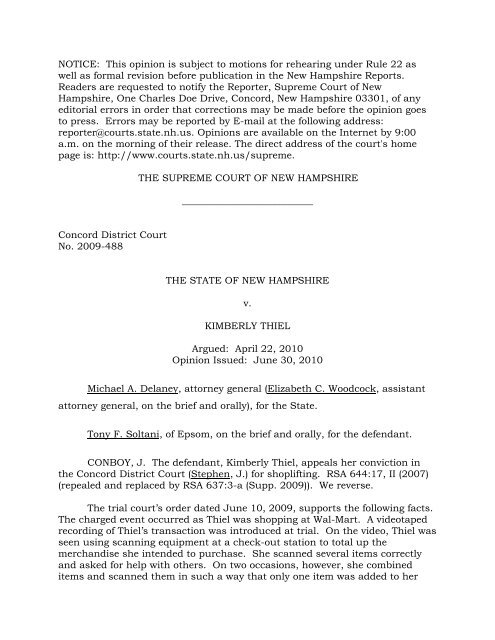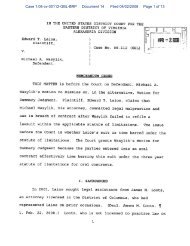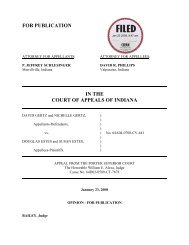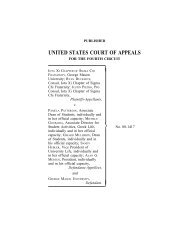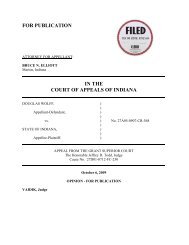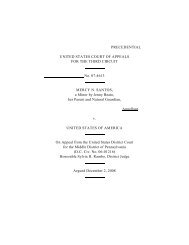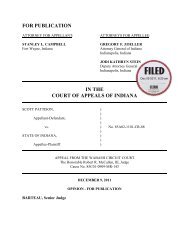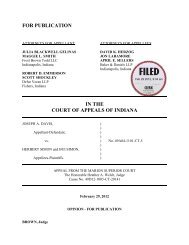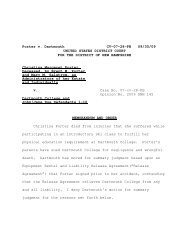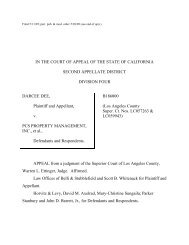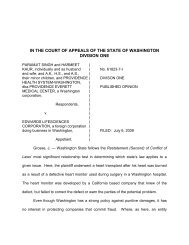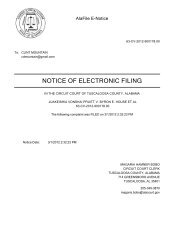NOTICE: This opinion is subject to motions for rehearing under Rule ...
NOTICE: This opinion is subject to motions for rehearing under Rule ...
NOTICE: This opinion is subject to motions for rehearing under Rule ...
Create successful ePaper yourself
Turn your PDF publications into a flip-book with our unique Google optimized e-Paper software.
<strong>NOTICE</strong>: <strong>Th<strong>is</strong></strong> <strong>opinion</strong> <strong>is</strong> <strong>subject</strong> <strong>to</strong> <strong>motions</strong> <strong>for</strong> <strong>rehearing</strong> <strong>under</strong> <strong>Rule</strong> 22 as<br />
well as <strong>for</strong>mal rev<strong>is</strong>ion be<strong>for</strong>e publication in the New Hampshire Reports.<br />
Readers are requested <strong>to</strong> notify the Reporter, Supreme Court of New<br />
Hampshire, One Charles Doe Drive, Concord, New Hampshire 03301, of any<br />
edi<strong>to</strong>rial errors in order that corrections may be made be<strong>for</strong>e the <strong>opinion</strong> goes<br />
<strong>to</strong> press. Errors may be reported by E-mail at the following address:<br />
reporter@courts.state.nh.us. Opinions are available on the Internet by 9:00<br />
a.m. on the morning of their release. The direct address of the court's home<br />
page <strong>is</strong>: http://www.courts.state.nh.us/supreme.<br />
Concord D<strong>is</strong>trict Court<br />
No. 2009-488<br />
THE SUPREME COURT OF NEW HAMPSHIRE<br />
___________________________<br />
THE STATE OF NEW HAMPSHIRE<br />
v.<br />
KIMBERLY THIEL<br />
Argued: April 22, 2010<br />
Opinion Issued: June 30, 2010<br />
Michael A. Delaney, at<strong>to</strong>rney general (Elizabeth C. Woodcock, ass<strong>is</strong>tant<br />
at<strong>to</strong>rney general, on the brief and orally), <strong>for</strong> the State.<br />
Tony F. Soltani, of Epsom, on the brief and orally, <strong>for</strong> the defendant.<br />
CONBOY, J. The defendant, Kimberly Thiel, appeals her conviction in<br />
the Concord D<strong>is</strong>trict Court (Stephen, J.) <strong>for</strong> shoplifting. RSA 644:17, II (2007)<br />
(repealed and replaced by RSA 637:3-a (Supp. 2009)). We reverse.<br />
The trial court’s order dated June 10, 2009, supports the following facts.<br />
The charged event occurred as Thiel was shopping at Wal-Mart. A videotaped<br />
recording of Thiel’s transaction was introduced at trial. On the video, Thiel was<br />
seen using scanning equipment at a check-out station <strong>to</strong> <strong>to</strong>tal up the<br />
merchand<strong>is</strong>e she intended <strong>to</strong> purchase. She scanned several items correctly<br />
and asked <strong>for</strong> help with others. On two occasions, however, she combined<br />
items and scanned them in such a way that only one item was added <strong>to</strong> her
ill. She then departed from the sales area with her bags of groceries and<br />
“proceeded <strong>to</strong> pass the au<strong>to</strong>matic doors that led <strong>to</strong> the vestibule.” One or more<br />
Wal-Mart employees s<strong>to</strong>pped Thiel in the vestibule area.<br />
On appeal, the defendant argues, inter alia, that in order <strong>to</strong> be guilty of<br />
shoplifting <strong>under</strong> RSA 644:17, II(a), she must have removed the goods from the<br />
merchant’s prem<strong>is</strong>es. Because she was s<strong>to</strong>pped in Wal-Mart’s vestibule, she<br />
contends that she did not leave the “prem<strong>is</strong>es” within the meaning of the<br />
statute.<br />
The State notes first that the defendant has failed <strong>to</strong> provide a transcript<br />
and citations <strong>to</strong> the record, and, there<strong>for</strong>e, there <strong>is</strong> an insufficient bas<strong>is</strong> upon<br />
which <strong>to</strong> consider her claims. The State further asserts that the trial court<br />
reasonably interpreted the leg<strong>is</strong>lature’s use of the word “prem<strong>is</strong>es.”<br />
We first “examine the threshold question whether an adequate record<br />
ex<strong>is</strong>ts <strong>to</strong> resolve th<strong>is</strong> <strong>is</strong>sue.” State v. Bergmann, 135 N.H. 97, 99 (1991). “It <strong>is</strong><br />
the burden of the appealing party <strong>to</strong> provide th<strong>is</strong> court with a record sufficient<br />
<strong>to</strong> decide the <strong>is</strong>sues ra<strong>is</strong>ed on appeal and <strong>to</strong> demonstrate that the appellant<br />
ra<strong>is</strong>ed those <strong>is</strong>sues be<strong>for</strong>e the trial court.” Mahmoud v. Irving Oil Corp., 155<br />
N.H. 405, 406 (2007) (quotation omitted); see also Sup. Ct. R. 16 (3)(b).<br />
“Failure of the moving party <strong>to</strong> comply with these requirements may be<br />
considered by the court regardless of whether the opposing party objects on<br />
those grounds.” Mahmoud, 155 N.H. at 406 (quotation and brackets omitted).<br />
The purpose of these requirements <strong>is</strong> <strong>to</strong> “provide evidence of preservation of the<br />
<strong>is</strong>sues <strong>for</strong> appeal and appr<strong>is</strong>e the respondent and the court of the <strong>is</strong>sues<br />
presented on appeal,” as well as <strong>to</strong> ensure that the record be<strong>for</strong>e us <strong>is</strong><br />
sufficiently developed <strong>to</strong> support a dec<strong>is</strong>ion on the merits. Id.<br />
Here, these requirements have been met. It <strong>is</strong> clear that the defendant<br />
ra<strong>is</strong>ed her statu<strong>to</strong>ry interpretation argument be<strong>for</strong>e the trial court, as the trial<br />
court’s order specifically responds <strong>to</strong> it. The notice of appeal also presents th<strong>is</strong><br />
argument. <strong>Th<strong>is</strong></strong> case <strong>is</strong> thus d<strong>is</strong>tingu<strong>is</strong>hable from the cases the State cites,<br />
Mahmoud, Bean v. Red Oak Prop. Mgmt., 151 N.H. 248 (2004), Bergmann, and<br />
State v. Staples, 120 N.H. 278 (1980). In those cases, a lack of record of the<br />
trial court’s proceedings left in doubt the trial court’s dec<strong>is</strong>ion on adm<strong>is</strong>sibility<br />
of prior convictions, Staples, 120 N.H. at 285, or the trial court’s reasoning<br />
<strong>under</strong>lying its findings, Bean, 151 N.H. at 250; Bergmann, 135 N.H. at 100, or<br />
even the very <strong>is</strong>sues in d<strong>is</strong>pute, Mahmoud, 155 N.H. at 406.<br />
We recognize that, where a case turns upon a factual d<strong>is</strong>pute and we<br />
lack a record <strong>to</strong> review, “we must assume that the evidence was sufficient <strong>to</strong><br />
support the result reached by the trial court.” Bean, 151 N.H. at 250. Here,<br />
however, the facts as found by the trial court are not in d<strong>is</strong>pute: Thiel was<br />
carrying items <strong>for</strong> which she had not paid, and she was s<strong>to</strong>pped outside of the<br />
2
sales area but within the vestibule of the s<strong>to</strong>re. Our statu<strong>to</strong>ry analys<strong>is</strong> does<br />
not require a record more complete than that which <strong>is</strong> be<strong>for</strong>e us. We,<br />
there<strong>for</strong>e, consider the defendant’s statu<strong>to</strong>ry argument, despite the absence of<br />
a transcript of the proceedings below.<br />
The State’s complaint charged Thiel with shoplifting <strong>under</strong> RSA 644:17,<br />
II, without alleging any of the enumerated variants. The complaint alleges that<br />
Thiel did “remove merchand<strong>is</strong>e, the property of Wal-Mart, merchand<strong>is</strong>e having<br />
a <strong>to</strong>tal value of $45.86, with a purpose <strong>to</strong> permanently deprive the owner<br />
thereof, in that the defendant stacked similar items, scanned only one, and left<br />
the s<strong>to</strong>re without paying <strong>for</strong> some of the merchand<strong>is</strong>e.” We consider these<br />
allegations as charging variant (a) of the statute, which provides that “[a]<br />
person <strong>is</strong> guilty of shoplifting if, with the purpose of depriving a merchant of<br />
goods or merchand<strong>is</strong>e, he knowingly . . . [r]emoves goods or merchand<strong>is</strong>e from<br />
the prem<strong>is</strong>es of a merchant.” RSA 644:17, II(a). Thiel argues that, because she<br />
was s<strong>to</strong>pped in the merchant’s vestibule, she did not remove goods or<br />
merchand<strong>is</strong>e from the prem<strong>is</strong>es, and the trial court erred in convicting her<br />
<strong>under</strong> th<strong>is</strong> statute.<br />
“We review questions of statu<strong>to</strong>ry interpretation and constitutional<br />
questions of law de novo.” State v. Offen, 156 N.H. 435, 437 (2007). “In<br />
matters of statu<strong>to</strong>ry interpretation, we are the final arbiter of the intent of the<br />
leg<strong>is</strong>lature as expressed in the words of a statute considered as a whole.” Id.<br />
(quotation omitted). “We construe prov<strong>is</strong>ions of the Criminal Code according <strong>to</strong><br />
the fair import of their terms and <strong>to</strong> promote justice.” State v. Kousounad<strong>is</strong>,<br />
159 N.H. 413, 423 (2009). We first look <strong>to</strong> the language of the statute itself,<br />
and, if possible, construe that language according <strong>to</strong> its plain and ordinary<br />
meaning. Id. “We interpret leg<strong>is</strong>lative intent from the statute as written and<br />
will not consider what the leg<strong>is</strong>lature might have said or add language that the<br />
leg<strong>is</strong>lature did not see fit <strong>to</strong> include.” Petition of State of N.H. (State v. Milner),<br />
159 N.H. 456, 457 (2009). “We must give effect <strong>to</strong> all words in a statute, and<br />
presume that the leg<strong>is</strong>lature did not enact superfluous or redundant words.”<br />
Id. “Finally, we interpret a statute in the context of the overall statu<strong>to</strong>ry<br />
scheme and not in <strong>is</strong>olation.” Kousounad<strong>is</strong>, 159 N.H. at 423.<br />
The shoplifting statute does not define “prem<strong>is</strong>es.” The trial court<br />
interpreted the statute as follows:<br />
To hold that the prem<strong>is</strong>es <strong>for</strong> the purposes of shoplifting must<br />
encompass the vestibule area would give r<strong>is</strong>e <strong>to</strong> a slippery slope<br />
that the court cannot reasonably conclude was intended by the<br />
leg<strong>is</strong>lature. For example, could it reasonably be argued that<br />
“prem<strong>is</strong>es” <strong>for</strong> the purpose of the stature [sic] also includes the<br />
parking lot since it <strong>is</strong> company owned land? The court thinks not.<br />
If it did include the parking lot, then someone could not lawfully be<br />
3
prosecuted <strong>for</strong> shoplifting until he or she gets in [h<strong>is</strong> or her] car<br />
and leaves the parking lot and enters the public way. It <strong>is</strong> more<br />
likely that the statu<strong>to</strong>ry intent of the leg<strong>is</strong>lature was that the sales<br />
area <strong>is</strong> the “prem<strong>is</strong>es” <strong>for</strong> the purposes of a shoplifting complaint.<br />
Since the Defendant had exited the sales area when she departed<br />
from the cash reg<strong>is</strong>ter area with her groceries all bagged up and<br />
then proceeded <strong>to</strong> pass the au<strong>to</strong>matic doors that led <strong>to</strong> the<br />
vestibule, the court rules that she had left the “prem<strong>is</strong>es” <strong>for</strong> the<br />
purposes of RSA 644:17 II.<br />
We d<strong>is</strong>agree with the trial court’s interpretation of the statute.<br />
While we need not here define the prec<strong>is</strong>e parameters of “prem<strong>is</strong>es” as<br />
used in the statute, we conclude that the trial court’s determination that the<br />
defendant left the merchant’s prem<strong>is</strong>es when she left its sales area <strong>is</strong> not<br />
cons<strong>is</strong>tent with the plain and ordinary meaning of the word. See Kousounad<strong>is</strong>,<br />
159 N.H. at 423. “Prem<strong>is</strong>es” <strong>is</strong> generally defined as “the place of business of an<br />
enterpr<strong>is</strong>e or institution,” Webster’s Third New International Dictionary 1789<br />
(unabridged ed. 2002), and <strong>is</strong> not delimited by particular activities within the<br />
place of business.<br />
Neither does the statu<strong>to</strong>ry scheme support the State’s position. RSA<br />
644:17 defines two crimes: willful concealment, RSA 644:17, I, and shoplifting,<br />
RSA 644:17, II. RSA 644:17, I, provides: “A person <strong>is</strong> guilty of willful<br />
concealment if, without authority, he willfully conceals the goods or<br />
merchand<strong>is</strong>e of any s<strong>to</strong>re while still upon the prem<strong>is</strong>es of such s<strong>to</strong>re. Goods or<br />
merchand<strong>is</strong>e found concealed upon the person shall be prima facie evidence of<br />
willful concealment.” RSA 644:17, II, <strong>under</strong> which the defendant was charged,<br />
defines the relevant variant of shoplifting as follows: “A person <strong>is</strong> guilty of<br />
shoplifting if, with the purpose of depriving a merchant of goods or<br />
merchand<strong>is</strong>e, he knowingly . . . [r]emoves goods or merchand<strong>is</strong>e from the<br />
prem<strong>is</strong>es of a merchant.” RSA 644:17, II(a). The d<strong>is</strong>tinction between willful<br />
concealment and shoplifting <strong>under</strong> RSA 644:17 occurs at the boundary of the<br />
merchant’s “prem<strong>is</strong>es”: within the boundary, the wrongful conduct constitutes<br />
“willful concealment”; outside the boundary, the wrongful conduct constitutes<br />
shoplifting. Given th<strong>is</strong> d<strong>is</strong>tinction, we cannot conclude that the leg<strong>is</strong>lature<br />
intended the boundary of a merchant’s prem<strong>is</strong>es <strong>to</strong> be delineated by its sales<br />
area.<br />
We agree with the State that “[t]he statute <strong>is</strong> intended <strong>to</strong> pun<strong>is</strong>h people<br />
<strong>for</strong> taking merchand<strong>is</strong>e from a s<strong>to</strong>re without first paying <strong>for</strong> it.” However, the<br />
variant of the statute <strong>under</strong> which Thiel was charged requires removal of the<br />
merchand<strong>is</strong>e from the merchant’s prem<strong>is</strong>es. Where, as here, there <strong>is</strong> no<br />
d<strong>is</strong>pute that the merchand<strong>is</strong>e was not removed from even the outer doors of the<br />
s<strong>to</strong>re, the statu<strong>to</strong>ry elements of the charged crime have not been met. While<br />
4
the State may have been able <strong>to</strong> prove the defendant guilty of attempted theft,<br />
see State v. Harper, 126 N.H. 815, 818 (1985), or theft, see State v. Peck, 140<br />
N.H. 333, 335 (1995), or attempted shoplifting, she was in fact charged with<br />
shoplifting by wrongfully removing goods from the merchant’s prem<strong>is</strong>es. Under<br />
these circumstances, we cannot conclude that the State met its burden of<br />
proof.<br />
5<br />
Reversed.<br />
BRODERICK, C.J., and DALIANIS, DUGGAN and HICKS, JJ., concurred.


